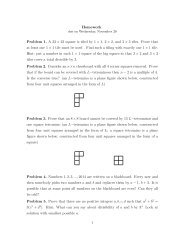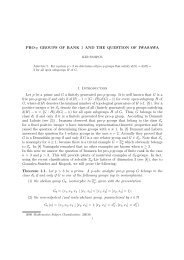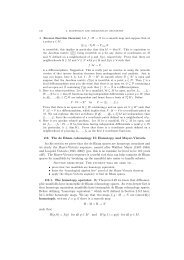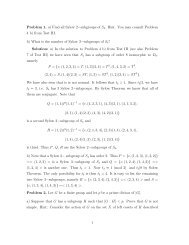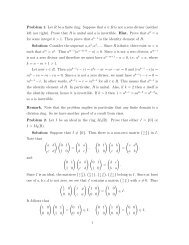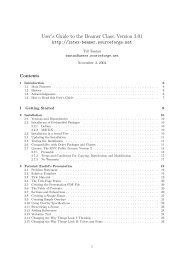Manual for SOA Exam MLC.
Manual for SOA Exam MLC.
Manual for SOA Exam MLC.
You also want an ePaper? Increase the reach of your titles
YUMPU automatically turns print PDFs into web optimized ePapers that Google loves.
Chapter 2. Survival models.<br />
<strong>Manual</strong> <strong>for</strong> <strong>SOA</strong> <strong>Exam</strong> <strong>MLC</strong>.<br />
Chapter 2. Survival models.<br />
Section 2.3. Force of Mortality.<br />
c○2009. Miguel A. Arcones. All rights reserved.<br />
Extract from:<br />
”Arcones’ <strong>Manual</strong> <strong>for</strong> <strong>SOA</strong> <strong>Exam</strong> <strong>MLC</strong>. Fall 2009 Edition”,<br />
available at http://www.actexmadriver.com/<br />
c○2009. Miguel A. Arcones. All rights reserved. <strong>Manual</strong> <strong>for</strong> <strong>SOA</strong> <strong>Exam</strong> <strong>MLC</strong>.<br />
1/31
Force of Mortality<br />
Chapter 2. Survival models. Section 2.3. Force of Mortality.<br />
Definition 1<br />
The <strong>for</strong>ce of mortality of the survival function SX is defined as<br />
µ(x) = − d<br />
dx ln SX (x) = fX (x)<br />
SX (x) .<br />
The <strong>for</strong>ce of mortality is also called the <strong>for</strong>ce of failure.<br />
An alternative notation <strong>for</strong> the <strong>for</strong>ce of mortality is µx. Force of<br />
mortality and <strong>for</strong>ce of failure are names used in actuarial sciences.<br />
c○2009. Miguel A. Arcones. All rights reserved. <strong>Manual</strong> <strong>for</strong> <strong>SOA</strong> <strong>Exam</strong> <strong>MLC</strong>.<br />
2/31
Chapter 2. Survival models. Section 2.3. Force of Mortality.<br />
Definition 2<br />
The hazard rate function of the survival function SX is defined as<br />
λX (x) = − d<br />
dx ln SX (x) = fX (x)<br />
SX (x) ,<br />
where SX is the survival function and fX is the probability density<br />
function of the distribution.<br />
The hazard rate is also called the failure rate. Hazard rate and<br />
failure rate are names used in reliability theory.<br />
c○2009. Miguel A. Arcones. All rights reserved. <strong>Manual</strong> <strong>for</strong> <strong>SOA</strong> <strong>Exam</strong> <strong>MLC</strong>.<br />
3/31
<strong>Exam</strong>ple 1<br />
Chapter 2. Survival models. Section 2.3. Force of Mortality.<br />
Find the <strong>for</strong>ce of mortality of the survival function SX (x) = 906−x 6<br />
906 <strong>for</strong> 0 < x < 90.<br />
c○2009. Miguel A. Arcones. All rights reserved. <strong>Manual</strong> <strong>for</strong> <strong>SOA</strong> <strong>Exam</strong> <strong>MLC</strong>.<br />
,<br />
4/31
<strong>Exam</strong>ple 1<br />
Chapter 2. Survival models. Section 2.3. Force of Mortality.<br />
Find the <strong>for</strong>ce of mortality of the survival function SX (x) = 906−x 6<br />
906 <strong>for</strong> 0 < x < 90.<br />
Solution: We have that<br />
µ(x) = − d<br />
dx ln SX (x) = − d<br />
dx ln<br />
<br />
906 − x 6<br />
906 <br />
= − d<br />
dx ln(906 − x 6 ) + d<br />
dx ln(906 ) =<br />
6x 5<br />
906 .<br />
− x 6<br />
c○2009. Miguel A. Arcones. All rights reserved. <strong>Manual</strong> <strong>for</strong> <strong>SOA</strong> <strong>Exam</strong> <strong>MLC</strong>.<br />
,<br />
5/31
Chapter 2. Survival models. Section 2.3. Force of Mortality.<br />
Theorem 1<br />
The hazard function of T (x) is<br />
λ T (x)(t|X > x) = µx+t, t ≥ 0.<br />
c○2009. Miguel A. Arcones. All rights reserved. <strong>Manual</strong> <strong>for</strong> <strong>SOA</strong> <strong>Exam</strong> <strong>MLC</strong>.<br />
6/31
Chapter 2. Survival models. Section 2.3. Force of Mortality.<br />
Theorem 1<br />
The hazard function of T (x) is<br />
λ T (x)(t|X > x) = µx+t, t ≥ 0.<br />
Proof: The survival function of T (x) is SX (x+t)<br />
SX (x) , t ≥ 0. Hence,<br />
λT (x)(t|X > x) = − d<br />
dt log<br />
<br />
SX (x + t)<br />
SX (x)<br />
= − d<br />
dt log(SX (x + t)) + d<br />
dt log(SX (x)) = fX (x + t)<br />
= µx+t.<br />
SX (x + t)<br />
c○2009. Miguel A. Arcones. All rights reserved. <strong>Manual</strong> <strong>for</strong> <strong>SOA</strong> <strong>Exam</strong> <strong>MLC</strong>.<br />
7/31
Chapter 2. Survival models. Section 2.3. Force of Mortality.<br />
Theorem 1<br />
The hazard function of T (x) is<br />
λ T (x)(t|X > x) = µx+t, t ≥ 0.<br />
Proof: The survival function of T (x) is SX (x+t)<br />
SX (x) , t ≥ 0. Hence,<br />
λT (x)(t|X > x) = − d<br />
dt log<br />
<br />
SX (x + t)<br />
SX (x)<br />
= − d<br />
dt log(SX (x + t)) + d<br />
dt log(SX (x)) = fX (x + t)<br />
= µx+t.<br />
SX (x + t)<br />
The hazard rate is the rate of death <strong>for</strong> lives aged x. For a life<br />
aged x, the <strong>for</strong>ce of mortality t years later is the <strong>for</strong>ce of mortality<br />
<strong>for</strong> a (x + t)–year old.<br />
c○2009. Miguel A. Arcones. All rights reserved. <strong>Manual</strong> <strong>for</strong> <strong>SOA</strong> <strong>Exam</strong> <strong>MLC</strong>.<br />
8/31
Chapter 2. Survival models. Section 2.3. Force of Mortality.<br />
<strong>Exam</strong>ple 2<br />
Suppose that the survival function of a new born is<br />
SX (t) = 854 −t 4<br />
85 4 , <strong>for</strong> 0 < t < 85.<br />
(i) Find the <strong>for</strong>ce of mortality of a new born.<br />
(ii) Find the <strong>for</strong>ce of mortality of a life aged x.<br />
c○2009. Miguel A. Arcones. All rights reserved. <strong>Manual</strong> <strong>for</strong> <strong>SOA</strong> <strong>Exam</strong> <strong>MLC</strong>.<br />
9/31
Chapter 2. Survival models. Section 2.3. Force of Mortality.<br />
<strong>Exam</strong>ple 2<br />
Suppose that the survival function of a new born is<br />
SX (t) = 854 −t 4<br />
85 4 , <strong>for</strong> 0 < t < 85.<br />
(i) Find the <strong>for</strong>ce of mortality of a new born.<br />
(ii) Find the <strong>for</strong>ce of mortality of a life aged x.<br />
Solution: (i) We have that<br />
µ(t) = − d<br />
dt ln SX (t) = − d<br />
dt ln<br />
<br />
854 − t4 854 <br />
= − d<br />
dt ln(854 − t 4 ) + d<br />
dt ln(854 ) = 4t3<br />
854 , 0 < t < 85.<br />
− t4 c○2009. Miguel A. Arcones. All rights reserved. <strong>Manual</strong> <strong>for</strong> <strong>SOA</strong> <strong>Exam</strong> <strong>MLC</strong>.<br />
10/31
Chapter 2. Survival models. Section 2.3. Force of Mortality.<br />
<strong>Exam</strong>ple 2<br />
Suppose that the survival function of a new born is<br />
SX (t) = 854 −t 4<br />
85 4 , <strong>for</strong> 0 < t < 85.<br />
(i) Find the <strong>for</strong>ce of mortality of a new born.<br />
(ii) Find the <strong>for</strong>ce of mortality of a life aged x.<br />
Solution: (i) We have that<br />
(ii)<br />
µ(t) = − d<br />
dt ln SX (t) = − d<br />
dt ln<br />
<br />
854 − t4 854 <br />
= − d<br />
dt ln(854 − t 4 ) + d<br />
dt ln(854 ) = 4t3<br />
854 , 0 < t < 85.<br />
− t4 µ(x + t) =<br />
4(x + t)3<br />
854 , 0 < t < 85 − x.<br />
− (x + t) 4<br />
c○2009. Miguel A. Arcones. All rights reserved. <strong>Manual</strong> <strong>for</strong> <strong>SOA</strong> <strong>Exam</strong> <strong>MLC</strong>.<br />
11/31
Chapter 2. Survival models. Section 2.3. Force of Mortality.<br />
Definition 3<br />
The cumulative hazard rate function is defined as<br />
Λ(x) =<br />
x<br />
0<br />
λX (t) dt, x ≥ 0,<br />
where λX is the hazard function of the r.v. X .<br />
Notice that<br />
x<br />
x<br />
d<br />
Λ(x) = λX (t) dt =<br />
0<br />
0 dt (− log SX (t)) dt<br />
<br />
x<br />
=(− log SX (t)) <br />
= − log SX (x), x ≥ 0,<br />
where SX is the survival function of the r.v. X .<br />
0<br />
c○2009. Miguel A. Arcones. All rights reserved. <strong>Manual</strong> <strong>for</strong> <strong>SOA</strong> <strong>Exam</strong> <strong>MLC</strong>.<br />
12/31
Chapter 2. Survival models. Section 2.3. Force of Mortality.<br />
Theorem 2<br />
Let µ(x) : [0, ∞] → R be a function which is continuous except at<br />
finitely many points. We have that µ is the <strong>for</strong>ce of mortality of an<br />
age–at–death r.v. if and only if the following two conditions hold:<br />
(i) For each x ≥ 0, µ(x) ≥ 0.<br />
µ(t) dt = ∞.<br />
(ii) ∞<br />
0<br />
Proof: If µ is a <strong>for</strong>ce of mortality, then µ(x) = fX (x)<br />
1−FX (x) ≥ 0 and<br />
∞<br />
0<br />
µ(t)dt =<br />
∞<br />
0<br />
− d<br />
dx (ln(SX (x))dt = − ln(SX (x)) ∞ = ∞. 0<br />
c○2009. Miguel A. Arcones. All rights reserved. <strong>Manual</strong> <strong>for</strong> <strong>SOA</strong> <strong>Exam</strong> <strong>MLC</strong>.<br />
13/31
Chapter 2. Survival models. Section 2.3. Force of Mortality.<br />
Suppose µ satisfies conditions<br />
(i) For each x ≥ 0, µ(x) ≥ 0.<br />
(ii) ∞<br />
0 µ(t) dt = ∞.<br />
Since µ is continuous everywhere except finitely many points<br />
x <br />
SX (x) = exp − µ(t) dt , x ≥ 0<br />
defines a survival function. By the fundamental theorem of<br />
calculus,<br />
− d<br />
dx (ln(SX (x)) = − d<br />
x <br />
µ(t) dt = µ(x),<br />
dx 0<br />
<strong>for</strong> all points x of continuity of µ.<br />
c○2009. Miguel A. Arcones. All rights reserved. <strong>Manual</strong> <strong>for</strong> <strong>SOA</strong> <strong>Exam</strong> <strong>MLC</strong>.<br />
0<br />
14/31
Chapter 2. Survival models. Section 2.3. Force of Mortality.<br />
<strong>Exam</strong>ple 3<br />
Determine which of the following functions is a legitime <strong>for</strong>ce of<br />
mortality of an age–at–death:<br />
(i) µ(x) = 1<br />
(x+1) 2 , <strong>for</strong> x ≥ 0.<br />
(ii) µ(x) = x sin x, <strong>for</strong> x ≥ 0.<br />
(iii) µ(x) = 35, <strong>for</strong> x ≥ 0.<br />
c○2009. Miguel A. Arcones. All rights reserved. <strong>Manual</strong> <strong>for</strong> <strong>SOA</strong> <strong>Exam</strong> <strong>MLC</strong>.<br />
15/31
Chapter 2. Survival models. Section 2.3. Force of Mortality.<br />
<strong>Exam</strong>ple 3<br />
Determine which of the following functions is a legitime <strong>for</strong>ce of<br />
mortality of an age–at–death:<br />
(i) µ(x) = 1<br />
(x+1) 2 , <strong>for</strong> x ≥ 0.<br />
(ii) µ(x) = x sin x, <strong>for</strong> x ≥ 0.<br />
(iii) µ(x) = 35, <strong>for</strong> x ≥ 0.<br />
Solution: (i) µ(x) = 1<br />
(x+1) 2 is not a <strong>for</strong>ce of mortality because<br />
∞<br />
0<br />
1<br />
1<br />
dx = −<br />
(x + 1) 2 x + 1<br />
<br />
<br />
<br />
<br />
∞<br />
0<br />
= 1.<br />
c○2009. Miguel A. Arcones. All rights reserved. <strong>Manual</strong> <strong>for</strong> <strong>SOA</strong> <strong>Exam</strong> <strong>MLC</strong>.<br />
16/31
Chapter 2. Survival models. Section 2.3. Force of Mortality.<br />
<strong>Exam</strong>ple 3<br />
Determine which of the following functions is a legitime <strong>for</strong>ce of<br />
mortality of an age–at–death:<br />
(i) µ(x) = 1<br />
(x+1) 2 , <strong>for</strong> x ≥ 0.<br />
(ii) µ(x) = x sin x, <strong>for</strong> x ≥ 0.<br />
(iii) µ(x) = 35, <strong>for</strong> x ≥ 0.<br />
Solution: (i) µ(x) = 1<br />
(x+1) 2 is not a <strong>for</strong>ce of mortality because<br />
∞<br />
0<br />
1<br />
1<br />
dx = −<br />
(x + 1) 2 x + 1<br />
<br />
<br />
<br />
<br />
∞<br />
0<br />
= 1.<br />
(ii) µ(x) = x sin x is not a <strong>for</strong>ce of mortality because x sin x < 0,<br />
<strong>for</strong> x ∈ (π, 2π).<br />
c○2009. Miguel A. Arcones. All rights reserved. <strong>Manual</strong> <strong>for</strong> <strong>SOA</strong> <strong>Exam</strong> <strong>MLC</strong>.<br />
17/31
Chapter 2. Survival models. Section 2.3. Force of Mortality.<br />
<strong>Exam</strong>ple 3<br />
Determine which of the following functions is a legitime <strong>for</strong>ce of<br />
mortality of an age–at–death:<br />
(i) µ(x) = 1<br />
(x+1) 2 , <strong>for</strong> x ≥ 0.<br />
(ii) µ(x) = x sin x, <strong>for</strong> x ≥ 0.<br />
(iii) µ(x) = 35, <strong>for</strong> x ≥ 0.<br />
Solution: (i) µ(x) = 1<br />
(x+1) 2 is not a <strong>for</strong>ce of mortality because<br />
∞<br />
0<br />
1<br />
1<br />
dx = −<br />
(x + 1) 2 x + 1<br />
<br />
<br />
<br />
<br />
∞<br />
0<br />
= 1.<br />
(ii) µ(x) = x sin x is not a <strong>for</strong>ce of mortality because x sin x < 0,<br />
<strong>for</strong> x ∈ (π, 2π).<br />
(iii) µ(x) = 35 is a legitime <strong>for</strong>ce of mortality.<br />
c○2009. Miguel A. Arcones. All rights reserved. <strong>Manual</strong> <strong>for</strong> <strong>SOA</strong> <strong>Exam</strong> <strong>MLC</strong>.<br />
18/31
Chapter 2. Survival models. Section 2.3. Force of Mortality.<br />
Theorem 3<br />
Suppose that µ(·) is the <strong>for</strong>ce of mortality of the age–at–death r.v.<br />
X . Then,<br />
(i) The survival function of X is<br />
t <br />
SX (t) = exp − µ(s) ds , t ≥ 0.<br />
0<br />
(ii) The density of X is<br />
t <br />
fX (t) = SX (t)µ(t) = exp − µ(s) ds µ(t), t ≥ 0<br />
0<br />
c○2009. Miguel A. Arcones. All rights reserved. <strong>Manual</strong> <strong>for</strong> <strong>SOA</strong> <strong>Exam</strong> <strong>MLC</strong>.<br />
19/31
Chapter 2. Survival models. Section 2.3. Force of Mortality.<br />
Theorem 3<br />
Suppose that µ(·) is the <strong>for</strong>ce of mortality of the age–at–death r.v.<br />
X . Then,<br />
(i) The survival function of X is<br />
t <br />
SX (t) = exp − µ(s) ds , t ≥ 0.<br />
0<br />
(ii) The density of X is<br />
t <br />
fX (t) = SX (t)µ(t) = exp − µ(s) ds µ(t), t ≥ 0<br />
0<br />
Proof: (i) By the fundamental theorem of calculus,<br />
<br />
exp −<br />
= exp<br />
t<br />
0<br />
<br />
µ(s) ds<br />
<br />
ln(SX (s)) t <br />
s=0<br />
<br />
= exp<br />
−<br />
x<br />
0<br />
− d<br />
ds (ln(SX<br />
<br />
(s)) ds<br />
= exp (ln(SX (t)) = SX (t)<br />
c○2009. Miguel A. Arcones. All rights reserved. <strong>Manual</strong> <strong>for</strong> <strong>SOA</strong> <strong>Exam</strong> <strong>MLC</strong>.<br />
20/31
Chapter 2. Survival models. Section 2.3. Force of Mortality.<br />
Theorem 3<br />
Suppose that µ(·) is the <strong>for</strong>ce of mortality of the age–at–death r.v.<br />
X . Then,<br />
(i) The survival function of X is<br />
t <br />
SX (t) = exp − µ(s) ds , t ≥ 0.<br />
0<br />
(ii) The density of X is<br />
t <br />
fX (t) = SX (t)µ(t) = exp − µ(s) ds µ(t), t ≥ 0<br />
0<br />
Proof: (ii) follows noticing that µ(t) = fX (t)<br />
s(t) .<br />
c○2009. Miguel A. Arcones. All rights reserved. <strong>Manual</strong> <strong>for</strong> <strong>SOA</strong> <strong>Exam</strong> <strong>MLC</strong>.<br />
21/31
Chapter 2. Survival models. Section 2.3. Force of Mortality.<br />
Theorem 4<br />
Suppose that µ(·) is the <strong>for</strong>ce of mortality of the age–at–death r.v.<br />
X . Then,<br />
(i) The survival function of T (x) is<br />
x+t <br />
ST (x)(t) = tpx = exp − µ(s) ds , t ≥ 0.<br />
x<br />
(ii) The density of T (x) is<br />
fT (x)(t) = ST (x)(t)µ T (x)(t) = e − R x+t<br />
x µ(y)dy<br />
µ(x + t), t ≥ 0.<br />
c○2009. Miguel A. Arcones. All rights reserved. <strong>Manual</strong> <strong>for</strong> <strong>SOA</strong> <strong>Exam</strong> <strong>MLC</strong>.<br />
22/31
Chapter 2. Survival models. Section 2.3. Force of Mortality.<br />
Theorem 4<br />
Suppose that µ(·) is the <strong>for</strong>ce of mortality of the age–at–death r.v.<br />
X . Then,<br />
(i) The survival function of T (x) is<br />
x+t <br />
ST (x)(t) = tpx = exp − µ(s) ds , t ≥ 0.<br />
x<br />
(ii) The density of T (x) is<br />
fT (x)(t) = ST (x)(t)µ T (x)(t) = e − R x+t<br />
x µ(y)dy<br />
µ(x + t), t ≥ 0.<br />
Proof: (i) The survival function of T (x) is<br />
tpx = SX (x + t)<br />
SX (x) =<br />
<br />
exp − <br />
x+t<br />
0 µ(s) ds<br />
exp − x+t <br />
x = exp − µ(s) ds .<br />
0 µ(s) ds x<br />
c○2009. Miguel A. Arcones. All rights reserved. <strong>Manual</strong> <strong>for</strong> <strong>SOA</strong> <strong>Exam</strong> <strong>MLC</strong>.<br />
23/31
Chapter 2. Survival models. Section 2.3. Force of Mortality.<br />
Theorem 4<br />
Suppose that µ(·) is the <strong>for</strong>ce of mortality of the age–at–death r.v.<br />
X . Then,<br />
(i) The survival function of T (x) is<br />
x+t <br />
ST (x)(t) = tpx = exp − µ(s) ds , t ≥ 0.<br />
x<br />
(ii) The density of T (x) is<br />
fT (x)(t) = ST (x)(t)µ T (x)(t) = e − R x+t<br />
x µ(y)dy<br />
µ(x + t), t ≥ 0.<br />
Proof: (i) The survival function of T (x) is<br />
tpx = SX (x + t)<br />
SX (x) =<br />
<br />
exp − <br />
x+t<br />
0 µ(s) ds<br />
exp − x+t <br />
x = exp − µ(s) ds .<br />
0 µ(s) ds x<br />
(ii) follows from µ T (x)(t) = f T (x)(t)<br />
S T (x)(t) .<br />
c○2009. Miguel A. Arcones. All rights reserved. <strong>Manual</strong> <strong>for</strong> <strong>SOA</strong> <strong>Exam</strong> <strong>MLC</strong>.<br />
24/31
Chapter 2. Survival models. Section 2.3. Force of Mortality.<br />
The cumulative distribution function of X is<br />
FX (t) = 1 − e − R t<br />
0 µ(y)dy , t ≥ 0.<br />
The cumulative distribution function of Tx is<br />
tqx = 1 − e − R x+t<br />
x µ(y)dy<br />
.<br />
c○2009. Miguel A. Arcones. All rights reserved. <strong>Manual</strong> <strong>for</strong> <strong>SOA</strong> <strong>Exam</strong> <strong>MLC</strong>.<br />
25/31
<strong>Exam</strong>ple 4<br />
Chapter 2. Survival models. Section 2.3. Force of Mortality.<br />
For the <strong>for</strong>ce of mortality µ(x) = 1<br />
x+1 <strong>for</strong> x ≥ 0, find SX , fX , tpx<br />
and f T (x).<br />
c○2009. Miguel A. Arcones. All rights reserved. <strong>Manual</strong> <strong>for</strong> <strong>SOA</strong> <strong>Exam</strong> <strong>MLC</strong>.<br />
26/31
<strong>Exam</strong>ple 4<br />
Chapter 2. Survival models. Section 2.3. Force of Mortality.<br />
For the <strong>for</strong>ce of mortality µ(x) = 1<br />
x+1 <strong>for</strong> x ≥ 0, find SX , fX , tpx<br />
and f T (x).<br />
Solution: We have that<br />
x <br />
x 1<br />
x<br />
µ(t) dt = dt = log(1 + t) <br />
t + 1 = log(1 + x), x ≥ 0.<br />
0<br />
0<br />
c○2009. Miguel A. Arcones. All rights reserved. <strong>Manual</strong> <strong>for</strong> <strong>SOA</strong> <strong>Exam</strong> <strong>MLC</strong>.<br />
0<br />
27/31
<strong>Exam</strong>ple 4<br />
Chapter 2. Survival models. Section 2.3. Force of Mortality.<br />
For the <strong>for</strong>ce of mortality µ(x) = 1<br />
x+1 <strong>for</strong> x ≥ 0, find SX , fX , tpx<br />
and f T (x).<br />
Solution: We have that<br />
x <br />
x 1<br />
x<br />
µ(t) dt = dt = log(1 + t) <br />
t + 1 = log(1 + x), x ≥ 0.<br />
0<br />
0<br />
x <br />
s(x) = exp − µ(t) dt = exp(− log(1 + x)) =<br />
0<br />
1<br />
, x ≥ 0.<br />
x + 1<br />
c○2009. Miguel A. Arcones. All rights reserved. <strong>Manual</strong> <strong>for</strong> <strong>SOA</strong> <strong>Exam</strong> <strong>MLC</strong>.<br />
0<br />
28/31
<strong>Exam</strong>ple 4<br />
Chapter 2. Survival models. Section 2.3. Force of Mortality.<br />
For the <strong>for</strong>ce of mortality µ(x) = 1<br />
x+1 <strong>for</strong> x ≥ 0, find SX , fX , tpx<br />
and f T (x).<br />
Solution: We have that<br />
x <br />
x 1<br />
x<br />
µ(t) dt = dt = log(1 + t) <br />
t + 1 = log(1 + x), x ≥ 0.<br />
0<br />
0<br />
x <br />
s(x) = exp − µ(t) dt = exp(− log(1 + x)) =<br />
0<br />
1<br />
, x ≥ 0.<br />
x + 1<br />
fX (x) = µ(x)s(x) =<br />
0<br />
1<br />
, x ≥ 0.<br />
(x + 1) 2<br />
c○2009. Miguel A. Arcones. All rights reserved. <strong>Manual</strong> <strong>for</strong> <strong>SOA</strong> <strong>Exam</strong> <strong>MLC</strong>.<br />
29/31
<strong>Exam</strong>ple 4<br />
Chapter 2. Survival models. Section 2.3. Force of Mortality.<br />
For the <strong>for</strong>ce of mortality µ(x) = 1<br />
x+1 <strong>for</strong> x ≥ 0, find SX , fX , tpx<br />
and f T (x).<br />
Solution: We have that<br />
x <br />
x 1<br />
x<br />
µ(t) dt = dt = log(1 + t) <br />
t + 1 = log(1 + x), x ≥ 0.<br />
0<br />
0<br />
x <br />
s(x) = exp − µ(t) dt = exp(− log(1 + x)) =<br />
0<br />
1<br />
, x ≥ 0.<br />
x + 1<br />
fX (x) = µ(x)s(x) =<br />
tpx =<br />
s(x + t)<br />
s(x)<br />
0<br />
1<br />
, x ≥ 0.<br />
(x + 1) 2<br />
x + 1<br />
= , x, t ≥ 0.<br />
x + t + 1<br />
c○2009. Miguel A. Arcones. All rights reserved. <strong>Manual</strong> <strong>for</strong> <strong>SOA</strong> <strong>Exam</strong> <strong>MLC</strong>.<br />
30/31
<strong>Exam</strong>ple 4<br />
Chapter 2. Survival models. Section 2.3. Force of Mortality.<br />
For the <strong>for</strong>ce of mortality µ(x) = 1<br />
x+1 <strong>for</strong> x ≥ 0, find SX , fX , tpx<br />
and f T (x).<br />
Solution: We have that<br />
x <br />
x 1<br />
x<br />
µ(t) dt = dt = log(1 + t) <br />
t + 1 = log(1 + x), x ≥ 0.<br />
0<br />
0<br />
x <br />
s(x) = exp − µ(t) dt = exp(− log(1 + x)) =<br />
0<br />
1<br />
, x ≥ 0.<br />
x + 1<br />
fX (x) = µ(x)s(x) =<br />
tpx =<br />
s(x + t)<br />
s(x)<br />
f T (x)(t) = tpxµ(x + t) =<br />
0<br />
1<br />
, x ≥ 0.<br />
(x + 1) 2<br />
x + 1<br />
= , x, t ≥ 0.<br />
x + t + 1<br />
x + 1<br />
, t ≥ 0.<br />
(x + t + 1) 2<br />
c○2009. Miguel A. Arcones. All rights reserved. <strong>Manual</strong> <strong>for</strong> <strong>SOA</strong> <strong>Exam</strong> <strong>MLC</strong>.<br />
31/31



